|
The Agfa Karat was only one of the many lines of cameras Agfa produced, it developed many other ranges including the Isolette and Record 120 rollfilm folding cameras, the collapsible lens Isola and the 35mm Silette and Selecta series. Personally I think that, with the exception of the Ambi Silette and some of the folders, they miss the appeal of the Karat series and I don't own many (but has grown considerably since first writing this).
Agfa Standard
Before the Karat series, Agfa mainly produced various folding and box cameras, the most common cameras at the time. An example of these was the Agfa Standard, an elegant folding camera available in a range of sizes for different film formats. Somewhat unusual, the camera had rail along which the shutter and lens were extended, but the actual focussing mechanism was a helical focus system on the shutter board. Most cameras at the time had a focussing rail instead. The camera was also available with a plate back, these models had a rectangular body instead of the rounded edges of the roll film variants. It was produced from the mid-1920s until the early 1930s.
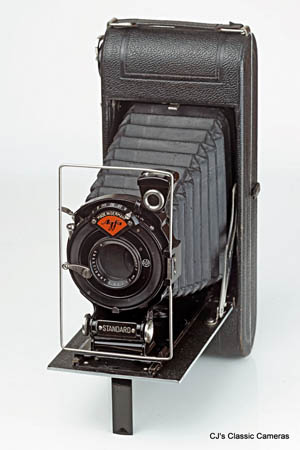
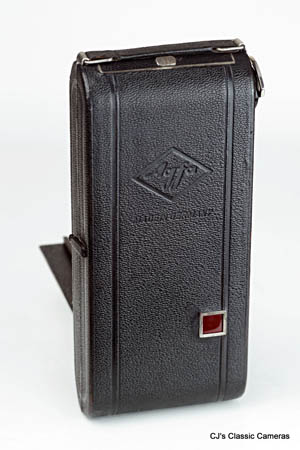
An Agfa Standard with 130 mm f/6.3 Agfa Anastigmat lens. The long focal length gives away that this camera was for a larger format than the common 6x9 format, indeed it was a version for D-6 or 117 roll film, which had a frame size of 6.3 x 11 cm (2.5 x 4 1/4"), although the film stock itself was 70mm wide. Also note the square shape of the red spy window at the back, which I think is unique to this model.
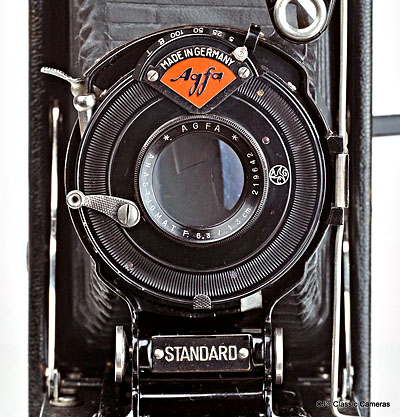 | |
Detail of the front panel of the Agfa Standard. Note the prominent orange Agfa logo with black lettering, a style which persisted throughout Agfa's lifetime and is still part of its current branding.
The lens nr and body serial number (AX 359) suggest this is an early production model, probably 1926. |
Agfa Memo
The Agfa Memo was a small 35mm folding camera introduced just before WWII. It was a rather unique camera amongst the Agfa models. First of all, it was made in the USA, not Germany, as part of the Agfa Ansco Corporation, which came to be when Ansco merged with Agfa in 1928. The camera used film cassettes, but these were different than the ones used in the Agfa Karat. Finally, the camera had a horizontal sliding mechanism at the back for film transport. The cassettes and film transport mechanism were inherited from the Ansco Memo, which was a small 35mm box camera that predated the Agfa Karat range.
The Ansco cassette was lower but wider than the Karat cassette, so the two were not interchangeable, but the Agfa Memo was designed such that Karat cassettes would in fact fit. Whether it was actually marketed in Europe, where the Rapid cassette was more prevalent, I am not sure off.
The Agfa Memo was an attractive little camera of high build quality. Metal parts were finished in nickel, which makes it seem older than its introduction year of 1939. It came in a few variants. The lower specified models had three-speed shutters and a strange crinkly body covering, whereas the higher specified models had 7-speed shutters with speeds down to 1/2 s, leather covering and a depth of field indicator as well as accessory shoe mounted on the top of the camera. The Memo was available with three different speeds, f/5.6, f/4.5 or f/3.5. Production did not last long due to the USA involvement in WWII and was not restarted once the war ended.
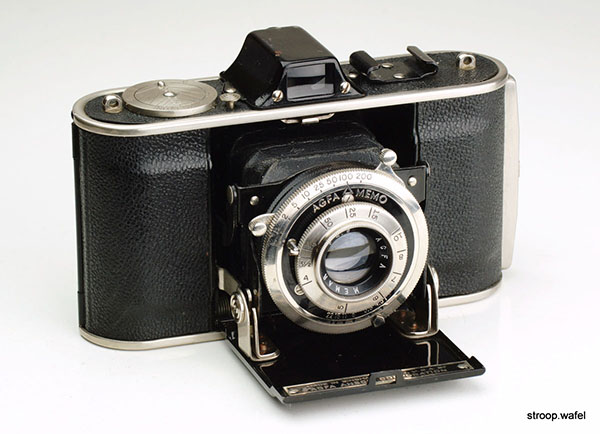
An Agfa Memo with Memar f/4.5 lens of unspecified focal lenght in unnamed 7-speed shutter.
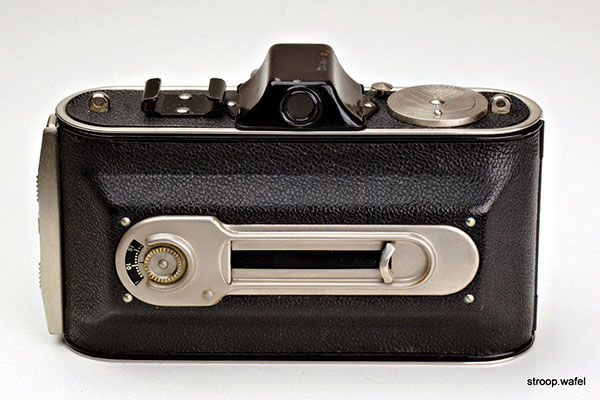
Rear view of an Agfa Memo showing its sliding film transport mechanism. A similar mechanism was later employed on the Beirette K.
Agfa Billy-Clack
In addition to the Agfa Standard above, Agfa produced several other ranges of folding cameras, most inportantly the Agfa Billy range, which were mostly 6x9 cameras in the style of the Kodak Folding Brownie, and the Agfa Isolette, which were 6x6 cameras. One Billy variant was the 1934 Billy-Clack, which had a scissor-like strut folding mechanism so that the baseboard with lens and shutter would pop straight out of the camera body, not unlike e.g., the Kodak Vest Pocket. Perhaps this inspired the Agfa Karat strut mechanism, which worked differently but had the same effect: the lens board was always parallel to the film plane, minimizing alignment errors that often plagued folding cameras. I suspect the Billy-Clack deriverd its name from the loud clack sound it made when the camera sprung open.
The Billy-Clack had an attractive Art Deco styling and came in two main variants of slightly different size, a proper 6x9 version and a 'half-frame' 4.5x6 version, both using 120 rollfilm. It had rather simple specifications, a single speed everset shutter, a doublet lens and a rotating diaphragm with three different stops, the fastest being f/11 on the 6x9 version and f/8.8 on the 4.5x6 version. The Billy-Clack was produced until the start WWII.
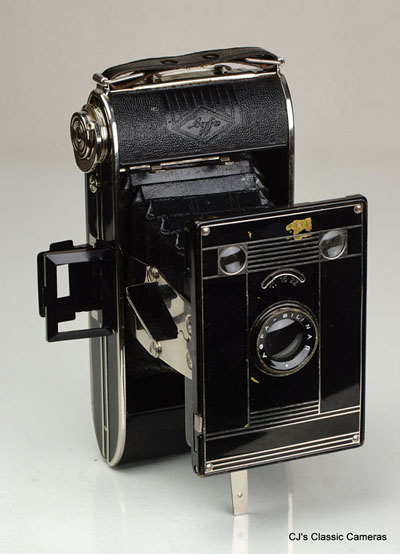
|
|
A 6x9 Agfa Billy-Clack with Agfa-Bilinar f/11 lens. |
Agfa Record III
After WWII the Agfa Billy evolved into the Record (initially called the Billy Record), a range of sleek and relatively compact folders. The Agfa Record III was produced from 1952-1955 and had an uncoupled rangefinder with a front-cell focussing lens, most commonly a three-element Apotar or a four-element Solinar. It was very light for its size and quite compact compared to most other 6x9 cameras from that era.
The only folding camera with coupled rangefinder and unit focussing that Agfa produced was the 6x6 Super Isolette, not counting the very rare and amazing Automatic 66 with light meter and semi-automatic exposure (!), both still highly sought-after cameras (see further down).
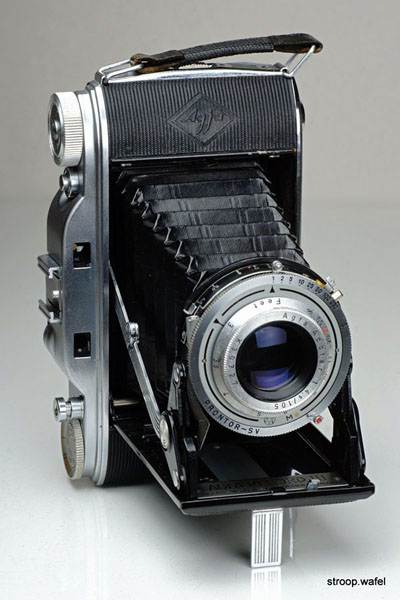
|
|
An Agfa Record III with coated Apotar 105/4.5 lens in Prontor-SV shutter. Like most folding cameras from the 1950s it was fully manual, although it did have a double-exposure prevention mechanism. The uncoupled rangefinder was of great help in avoiding out-of-focus pictures, especially when shooting at close range with large aperture. |
Agfa Isolette
As mentioned above, the Isolettes were Agfa's 6x6 rollfilm camera range. They were first introduced several years before WWII as the Isorette (with the German capital I written as a J), which had a black plastic tophousing presumably made of the same 'Trolitan' bakelite variant as some of the Agfa Karat Art Decos. It sported an Igestar f/6.3 lens. Soon after the name was changed to Isolette with no or little change to the camera itself, although the range of lenses and shutters was expanded. A very similar camera, the Agfa (or Ansco) Speedex B2, named after the shutter, was marketed in the USA. It had an extra knob in the rewind knob position but missed the dual format option. Note that B2 was also the Agfa name for Kodak 120 film at the time.
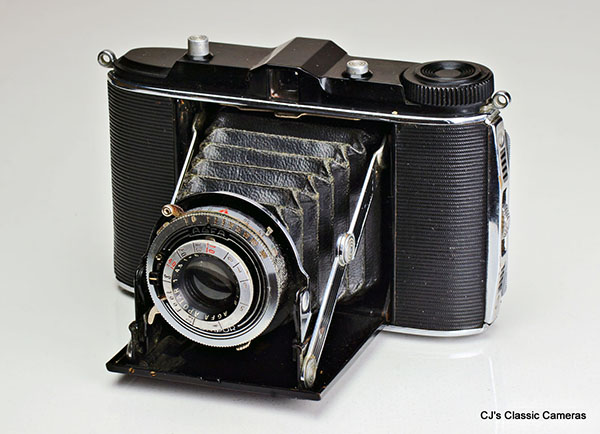
An Agfa Jsolette with 85mm f/4.5 Apotar lens in Compur shutter. Even though on the Karats the Apotar lens indicate a post WWII model, this example is from before WWII, as indicated by the serial# of the shutter and lens (all similar to pre-WWII Karats). This is a dual format camera, it has a lever next to the eye piece to change modes, an integrated mask in the film gate and a second red spy window at the back for use in 16 on 120 mode.
After WWII the black plastic tophousing was replaced by an aluminium metal one and soon after an accessory shoe and a T-button were added, as well as a double-exposure prevention mechanism. According the manual these were available with Apotar in Prontor II or Compur-Rapid shutter or Solinar in Compur-Rapid. It no longer had the dual format option.
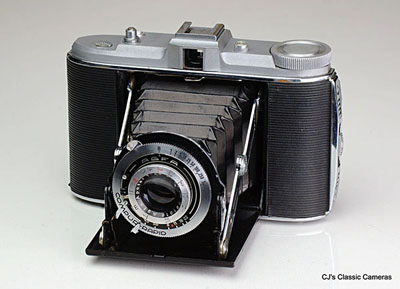
| |
A post-WWII Agfa Jsolette, again with 85mm f/4.5 Apotar lens but here in Compur-Rapid shutter.
|
Around 1950 the range was... well, modernised isn't the right word, let's say diversified. Several varieties of different specification were made, indicated by numbers on the front door, and Isolette spelled with 'I' not 'J'. Most notable were the Isolette III with uncoupled rangefinder and the Isolette II with a wind mechanism and double-exposure lock. The Isolette I and V were more simple models with and without body-mounted shutter release, respectively. All models could be found with a variety of shutters and lenses of various quality and performance. Somewhat unusually, most Isolettes came with fairly long 85mm lenses, except for the Isolette II and III which could also be found with a 75mm f/3.5 Solinar (but note the slower /4.5 Solinar was 85mm again). You can't swap the 85mm and 75mm lenses if you were so inclined, as the lens board on the 75mm version is set back a little (10 mm to be exact) compared to the 85mm version.
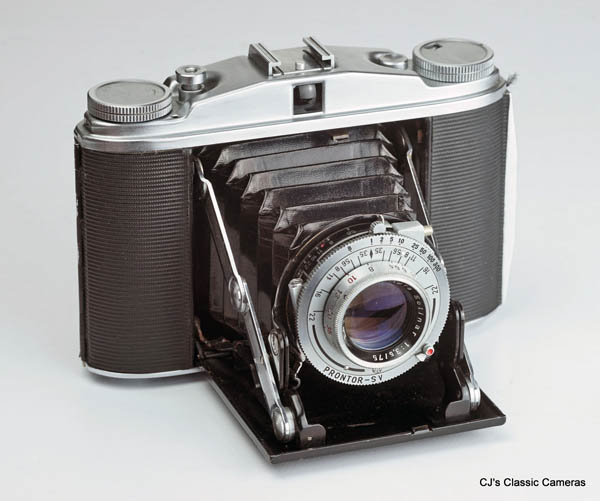
An Agfa Isolette II with 75mm f/3.5 Solinar four-element lens in Prontor-SV shutter.
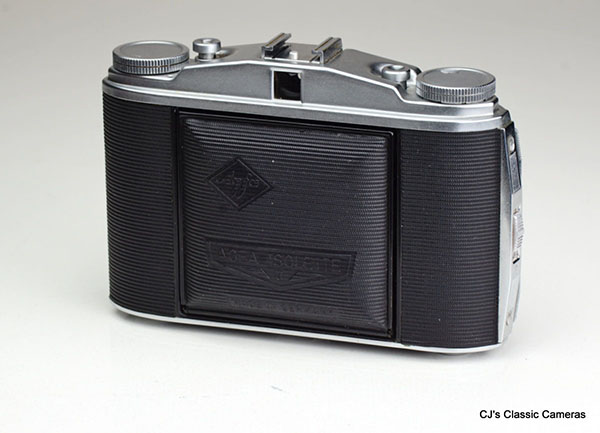
Figuring out which version of Isolette you are dealing with can be a little confusing due to the many variants available, but the version was printed on the front foor, beneath the Agfa Isolette name.
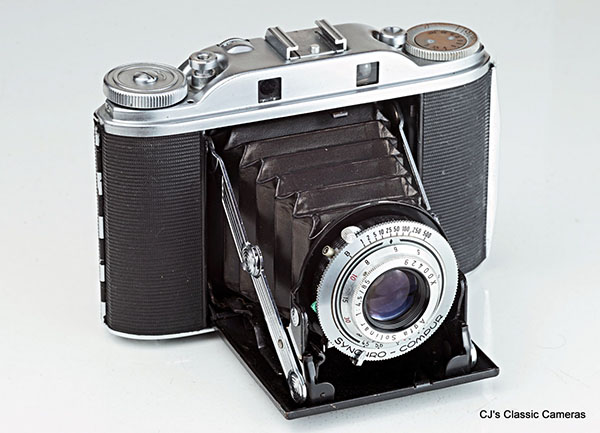
An Agfa Isolette III with 85mm f/4.5 Solinar lens in Synchro-Compur shutter, easily recognisable as it is the only Isolette with two windows due to its rangefinder. This was the most expensive variant of this model (apart from the faster f/3.5 Solinar variant), cheaper variants having Apotar lenses and Pronto or Prontor shutters.
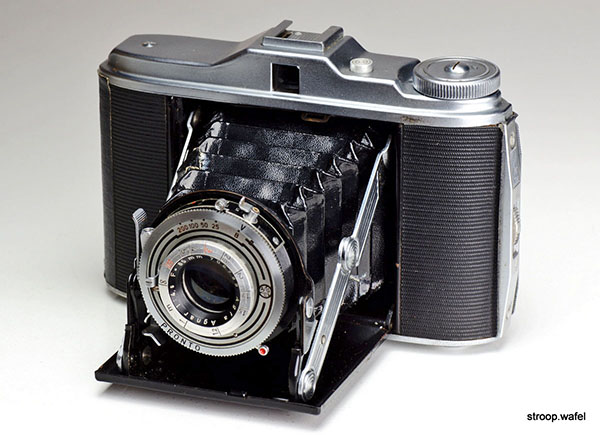
An Agfa Isolette V with 85mm f/4.5 Agnar triplet lens in Pronto shutter. Note the striped body covering which was typical for most Agfa folding cameras. The bellows on the Karat folders had a bad reputation, so it is not surprising that the one on this example had many repairs.
Agfa Isolette-L
This is yet another variant of the Agfa Isolette range discussed above, but with a modernised styling and, importantly, the addition of an uncoupled lightmeter. I have only seen this model with a 85mm f/4.5 Apotar lens, like most earlier Isolettes, and not with the more desirable Solinar lens. This was one of Agfa's last folding medium format cameras, other than the Agfa 66 Automatic below, which featured a lightmeter as well as a rangefinder.
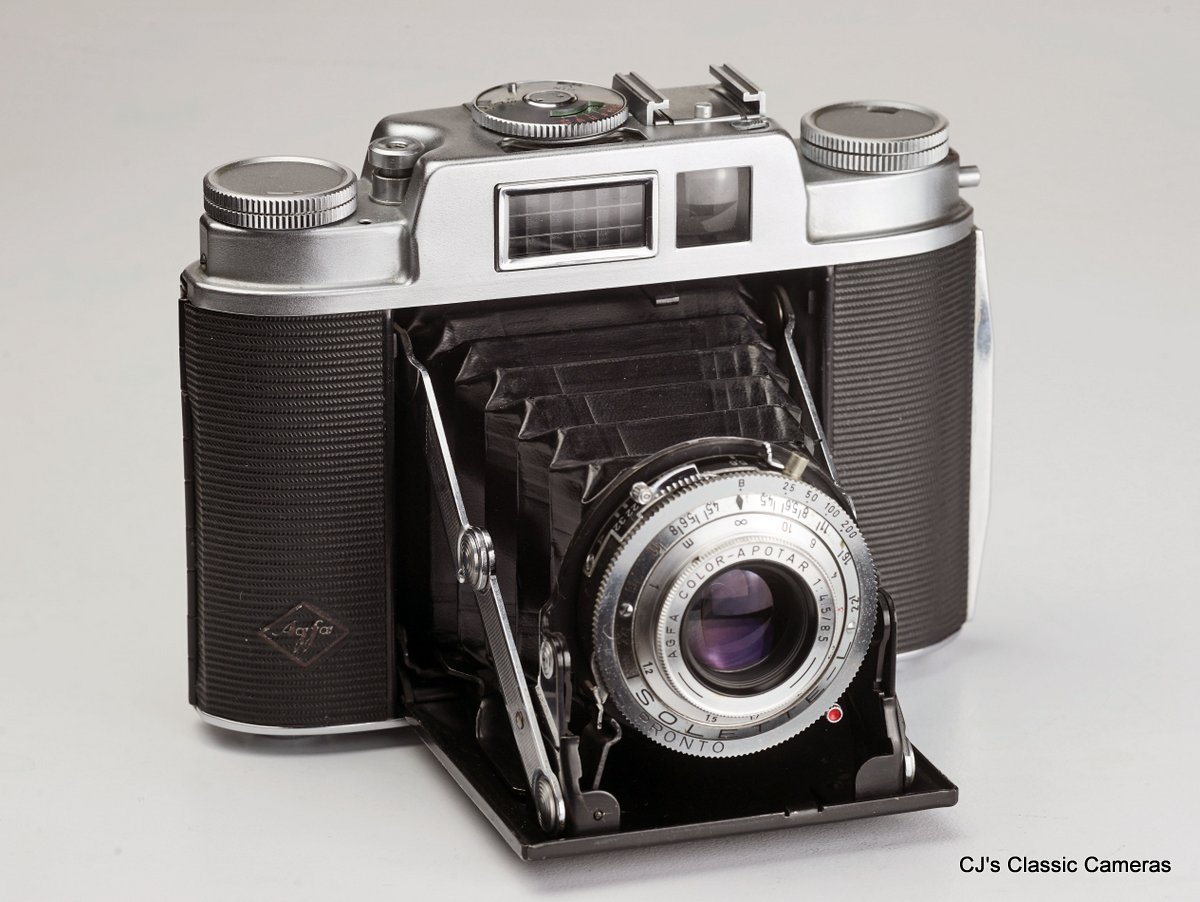
An Agfa Isolette-L with 85mm f/4.5 Color-Apotar lens in Pronto shutter.
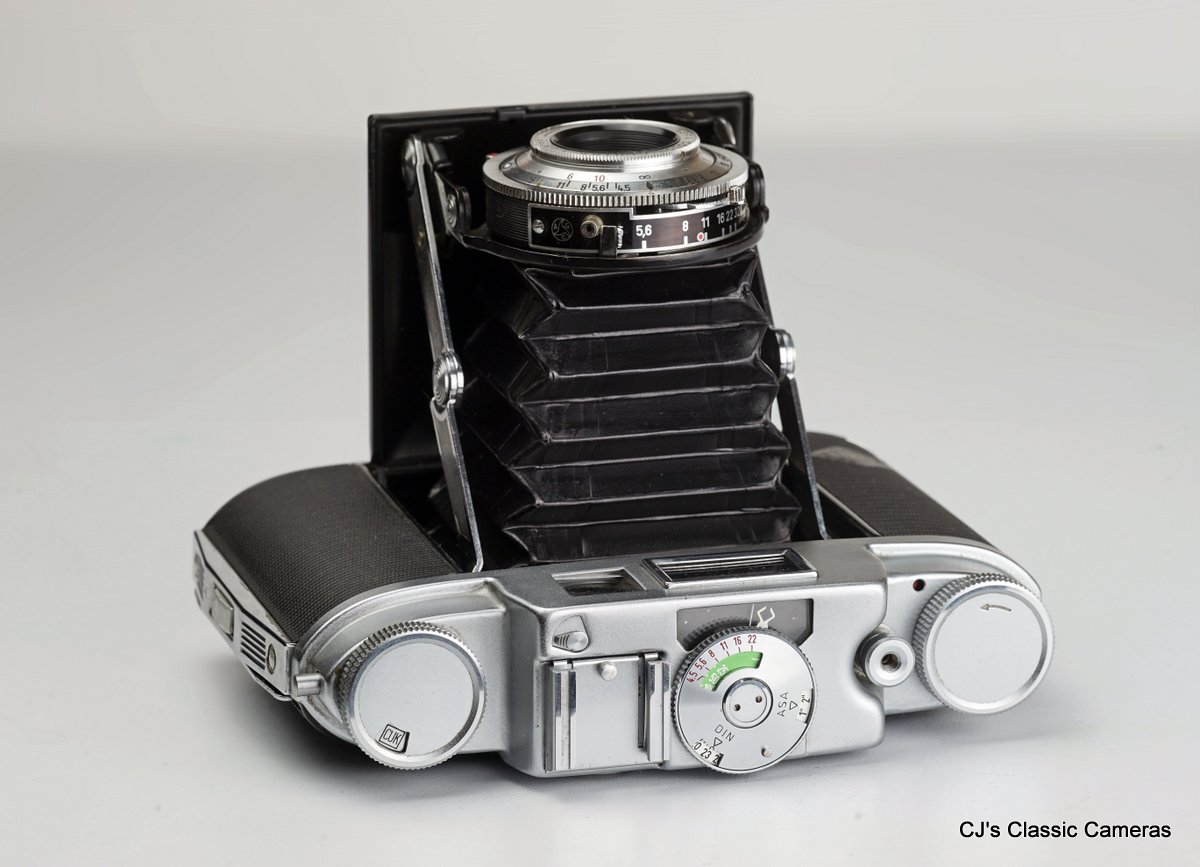
Top view of the Agfa Isolette-L, clearly displaying the lightmeter unit. After aligning the indicator with the lightmeter needle one could read off suitable shutter speed-aperture combinations, a lot easier to use than the light value system which was also popular at the time. The small switch just above the viewfinder was there to adjust the view from 6x6 to 6x4 format, the camera also came with an adjustable mask in the film chamber for that purpose.
Ansco Titan
As mentioned above, the Agfa Isolette range was sold in the USA under the name Ansco Speedex. However, some variants were unique to (and build by) Ansco, even though they were clearly based on the early Isolette range. One such model was the 1948 Ansco Titan, which had a distinctive shaped top housing with large conical wind knobs. It was equipped with a Ansco Anastigmat 90mm f/4.5 lens, which was a rather long focal length for its 6x6 film format, and an unspecified shutter with a wide range of speeds from 1/2 to 1/400s. A similar model with a black plastic top housing, less distinctive wind knobs, slower lens and more simple shutter was sold as Ansco Standard Speedex. Hence, the Titan was the only Isolette-style camera made by Ansco that was not called 'Speedex'. One had to pay dearly for such an exclusive model, retailing at $69.50 in 1951 compared to $39.50 for its Speedex sibbling. Whether the name Titan was a reference to titanium, an exclusive metal at the time, or the Greek gods of giant strength I am not sure.
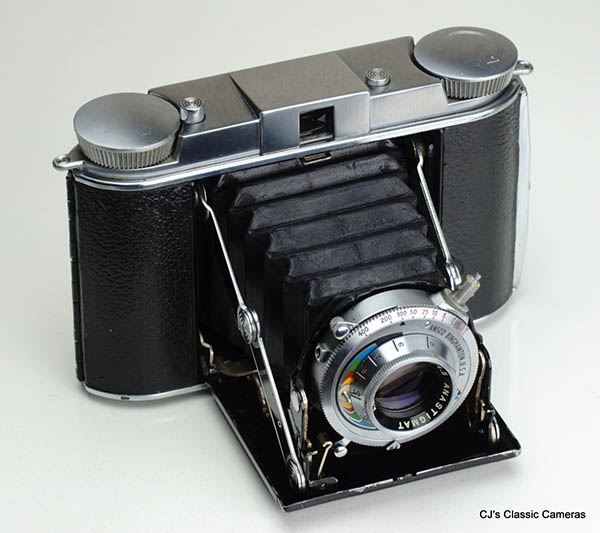
The sleek-looking Ansco Titan with its Ansco Anastigmat 90mm f/4.5 lens.
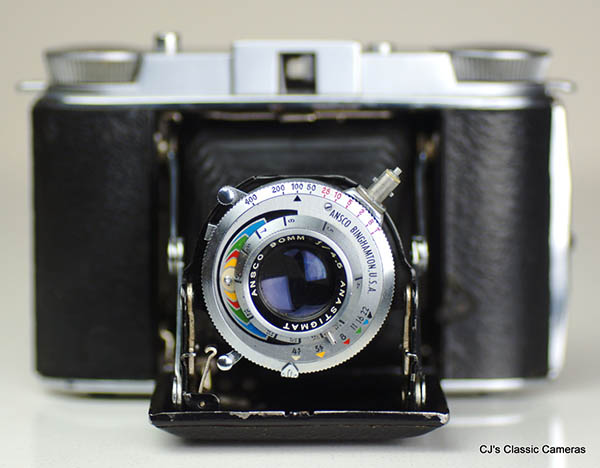
In addition to its distinctive top housing the Ansco Titan also had an eye-catching shutter, with the depth of field for each aperture marked in different colours, plus a rather imposing flash sync socket.
Agfa Super Isolette
The top model of the Agfa Isolette range was without doubt the Super Isolette (or was it? See next camera...). It had a coupled rangefinder with a unit-focusing lens as well as an automatic wind mechanism so no red spy window to check the film advance was necessary, or indeed present. A frame counter on top of the camera would keep track of the frames and automatically reset to 0 when the camera back was opened. Another neat feature were the two knobs on the bottom plate, which with one twist would release the film spools on the inside. Agfa was clearly proud of this magnificent camera: the Super Isolette was the only camera in the Isolette range that had its name prominently displayed in-between the rangefinder windows.
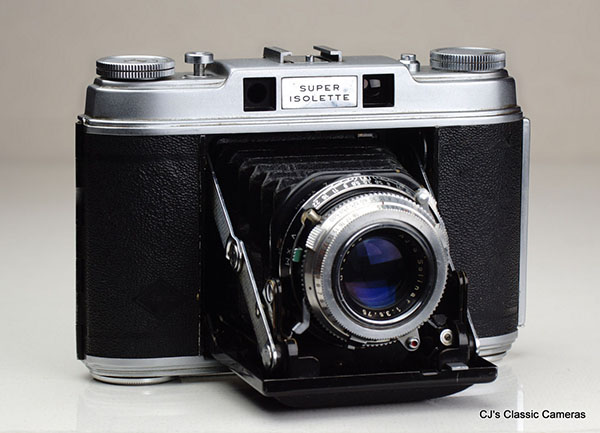
An Agfa Super Isolette with Agfa Solinar 75mm f/3.5 in Synchro-Compur shutter.
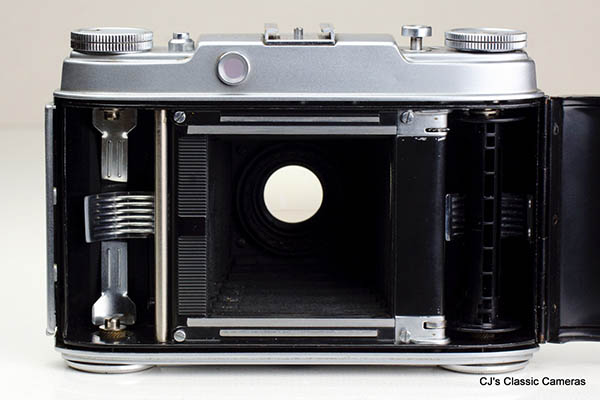
Inside rear view of the Agfa Super Isolette. Note the 'sprocket' wheel next to the right wind spool, which regulates film transport, but does leave you with perforated negatives...outside the film frame of course.
Agfa Automatic 66
In 1958 Agfa came out with the Automatic 66. It was based on the magnificent Super Isolette, but featured a lightmeter and an automatic exposure mechanism. It is sometimes claimed that it was the first medium format camera to do so, but that honour goes to the Kodak Super Six-20 from 1938. Nevertheless, it was one of the first. The exposure mechanism made use of an ingenious pneumatic mechanism which would activate a piston-driven shutter release. This mechanism was patented by Durst (see Durst Automatic) and in fact the Automatic 66 manual mentions this patent (but not that it's by Durst!). I assume Agfa paid Durst a fair price for using their technology.
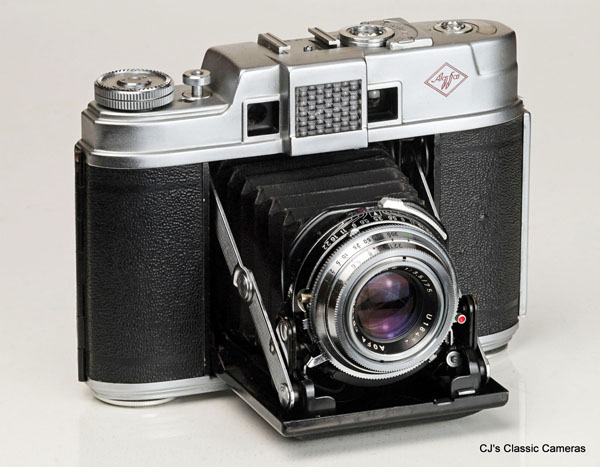
An Agfa Automatic 66 with Agfa Solinar 75mm f/3.5 in Synchro-Compur shutter.
The camera could of course also be used in manual exposure mode. To use it in automatic mode, one needed to switch a button on top of the camera and set the shutter speed to a special 'A' setting. The camera would determine the shutter speed based on the aperture, i.e., aperture mode as one would call it today. One could change to the aperture and the exposure system would adjust the shutter speed, which could be read off on a small window on top of the camera. The camera also had an DIN or ASA dial for different films speeds. Changing this dial would simply open and close small blinds in front of the lightmeter cell.
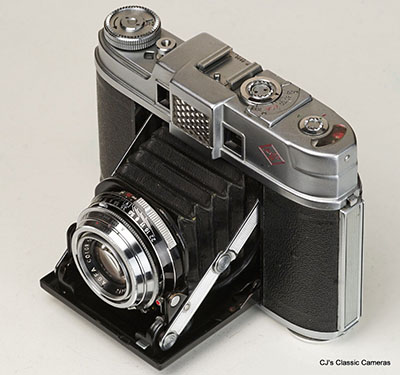
|
|
Other than that the camera was very similar in functionality to the Super Isolette, including the automatic wind mechanism and the excellent Solinar lens. However, Agfa didn't pay much attention to the aesthetics of the camera; the lightmeter unit stuck out and the asymmetry of the rather bulky top-housing was rather distracting. Also, the camera was expensive and sold poorly, which makes this a very rare item to find today.
I could only find a German manual so made an English translation with help of the Super Isolette manual,
|
|
Side view of the Agfa Automatic 66 with just visible behind the strut the air hose connecting the shutter release mechanism with the shutter itself.
|
you can find it here in my 'manuals' section.
|
Top view of the Agfa Automatic 66 showing the various controls and dials, including the film speed dial, the automation switch and the shutter speed read-out.
|
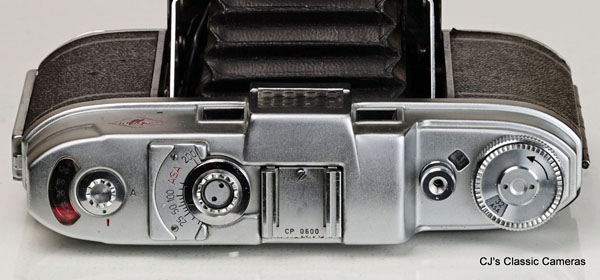
|
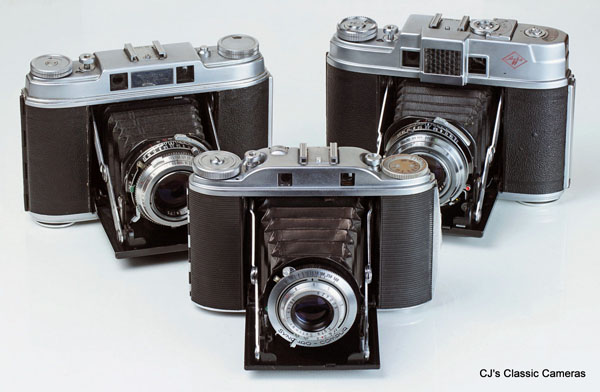
The Agfa medium-format rangefinder clan all together, with the uncoupled rangefinder Isolette III up front, and the coupled rangefinders Super Isolette and Automatic 66 behind.
Agfa (Super) Solinette
The Solinette was the 35mm folding camera line from Agfa, of which the Super Solinette was the coupled rangefinder version. Its looked quite similar to its non-folding cousins, the Agfa Silette range found below, apart from the folding bed of course. Although the viewfinder Silette came with a range of lenses and shutters, most commonly an Agfa Apotar in Prontor-SV shutter, the Super Solinette appears to have been produced only with the better four-element Solinar lens in Synchro-Compur shutter.
The lens had a helical focus mechanism, as typically only found on more expensive folding cameras. Rangefinder coupling was via a small lever in front of the edge of the shutter, which made adjustment easy when necessary. All in all a delightful little camera that only could have been improved upon by adding a windlever perhaps, and very much undervalued these days.
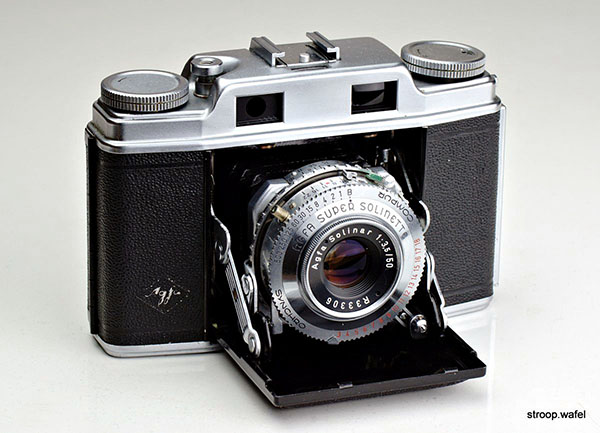
An Agfa Super Solinette with Solinar 50mm f/3.5 lens in Synchro-Compur shutter.
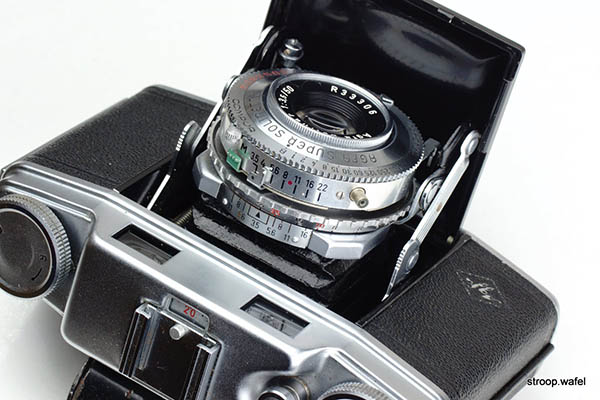
Detail of Agfa Super Solinette with Solinar 50mm f/3.5 lens in Synchro-Compur shutter showing the helical focus ring and shutter assembly. Also note the fairly unusual (for Agfa) position of the frame counter in front of the accessory shoe.
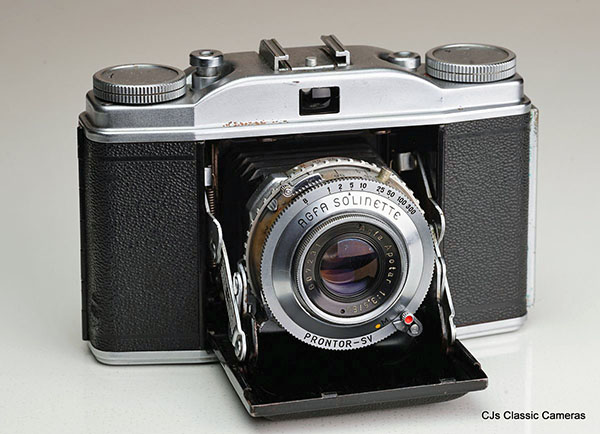
An example of the viewfinder version, an Agfa Solinette II with Agfa Apotar 50mm f/3.5 lens in Prontor-SV shutter. This one was a right mess when I got it, focus was frozen (a common Agfa problem), shutter was dripping in oil, viewfinder hazy, and sand and dust everywhere. But these cameras are good to work on as they come apart quite easily, so now it has a second lease of life.
Agfa Silette
The Agfa Silette was a simple viewfinder camera. It was well-build and formed the base for several other models, including the Ambi Silette, Karat IV and the Super Silette. It had a wind lever with integrated frame counter and had a film reminder dial in the rewind knob. The front-cell focussing lens was an Apotar f/3.5, later updated to f/2.8.
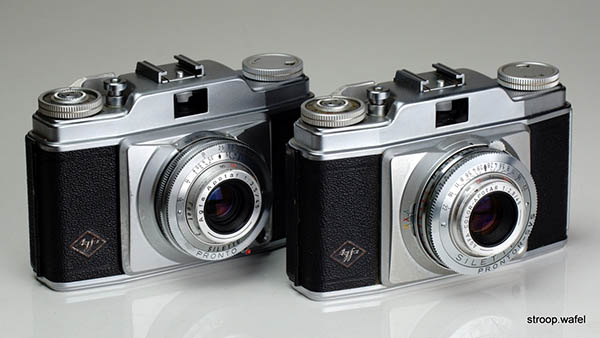
Two Agfa Silette cameras, an early example with f/3.5 Apotar in Pronto shutter on the left and a later one with f/2.8 Color-Apotar in Prontor-SVS on the right. The early version had a screwed-on depth of focus scale on top of the lens base, whereas on the later version this scale was integrated in the shutter mount.
Agfa Super Silette
The Agfa Super Silette was the rangefinder version of the Agfa Silette above. It sported a wind lever and a coupled rangefinder, so decent enough but somewhat unremarkable. It came with a choice of three lenses, a three-element Apotar f/3.5 (later versions f/2.8), a four-element Solinar or a six-element Solagon f/2, the latter obviously superior and still sought after. The Apotar and Solinar versions had front-cell focussing lenses, but the Solagon version had a helical focus mount with a focus tab on the left side of the lens (from a user's viewpoint). This version was also recognisable by the Agfa logo engraved in red inbetween the rangefinder windows. It was also available as the Ansco Super Memar.
Years later the Super Silette was restyled and updated in larger, more plasticky and squarer design, not unlike the Kodak Retina Automatic range.
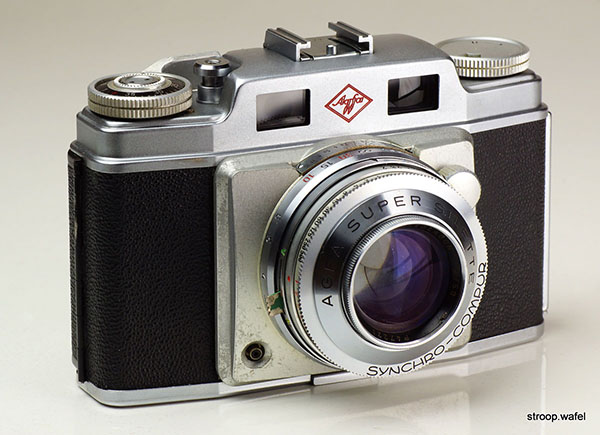
An early version of the Agfa Super Silette with 6-element f/2 Solagon in Sychro-Compur shutter. As is obvious from the design, it is from the same era as the Ambi Silette below and the Karat IV elsewhere on this site. As with many Silettes the paint on the lens base is rather worn. This particular example looked a mess when I opened it up for cleaning, it seemed to have enjoyed a beach holiday with its previous owner!
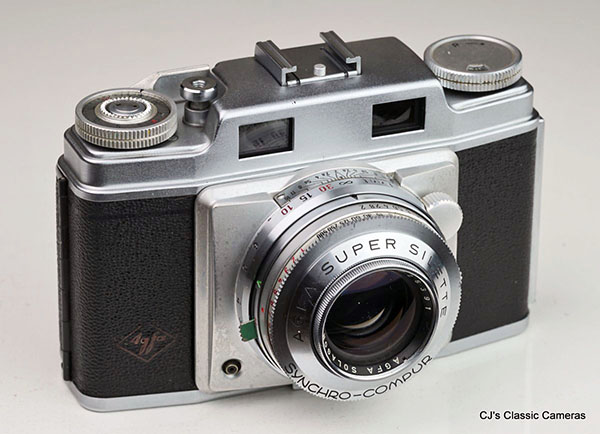
An earlier version of the Agfa Super Silette with Solagon which had not yet an Agfa logo engraved between its rangefinder windows, and looked therefore more similar to the Solinar and Apotar versions below.
I haven't quite figured out the serial# system of the Super Silettes, which is similar to that of the Karat range but appears to have a different sequence. However, cameras can be compared based on the serial# of the Solagon lens:
The Solagon lens first appeared on the Karat 36 in small numbers, and was thereafter fairly commonly mounted on Karat IVs from around P06000. The earliest 'old-style' Super Silettes with Solagon that I have seen had a serial# around P25000. The switch to the new style Solagon Silette with red logo was around P32000, when the Karat IV was also still in production (note it has a similar logo). From around P40000 the Karat IV had been phased out so the Super Silette was the only Agfa camera with fixed Solagon lens. From around P45000 until end of production (ca. P49000) the Solagon was named Color-Solagon.
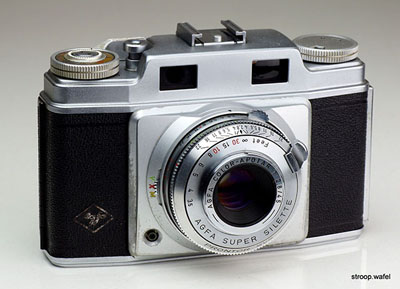
| |
A later version of the Agfa Super Silette with 3-element Color-Apotar f/2.8 lens in Prontor-SVS shutter.
|
|
Yet another version of the Agfa Super Silette, this one with 4-element Solinar 45mm f/3.5 lens in Sychro-Compur shutter. From what I have seen for sale over the years, this appears to be the rarest version, but opinions differ. It is certainly less common than the version with Apotar lens.
| |
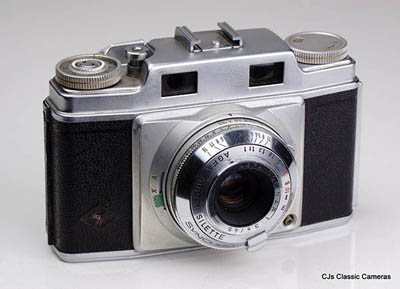
|
Agfa Silette SL
The Agfa Silette SL was introduced in 1957 and featured a coupled lightmeter, the first Agfa to do so. By adjusted the aperture or shutter speed an indicator would move in the lightmeter window, by aligning this indicator with the lightmeter needle proper exposure was achieved. A similar system could be found on the King Regula IIIbk.
The lightmeter cell was hidden behind a small flap which would flip open by pushing a small button on top of the camera. The styling of the camera is similar to the Ambi Silette below. It featured a 4-element Color-Solinar 50mm f/2.8 lens.
A cheaper version was the Silette LK, which did not have the little flap in front of the lightmeter cell and had a less well-specified Apotar lens and Pronto-LK shutter. A version with uncoupled lightmeter was the Silette-L, which did have the little Agfa logo flap.
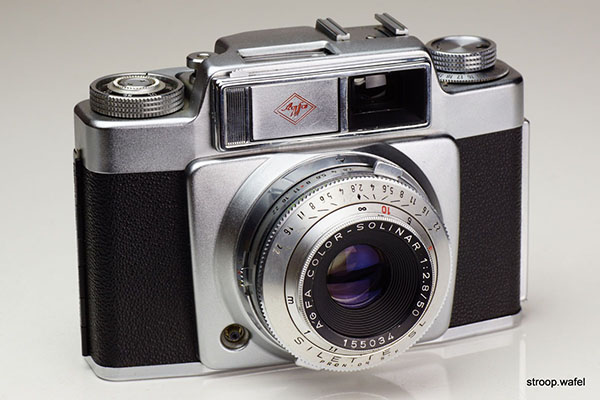
Agfa Silette SL with Color-Solinar 50mm f/2.8. Moving the mouse pointer over the image will open the lightmeter flap.
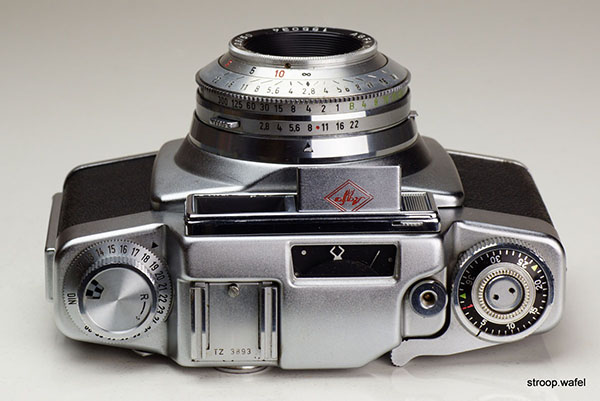
Top view of the Silette SL showing the coupled lightmeter window. The indicator visible in the middle moves when turning aperture or speedring and needs to be aligned with the lightmeter needle for proper exposure.
Agfa Ambi Silette
The 1957 Agfa Ambi Silette was essentially a Super Silette with exchangeable lens mount. It was initially available with 35mm, 50mm and 90mm lenses, later a 130mm lens was added to the range. It had a very clear double-image coupled rangefinder with parallax correction and frames for different focal lengths which could be selected by a switch on the top housing. The rangefinder had a cover with the name Ambi Silette on it, a small push would flipped it open. The shutter was a Synchro-Compur, but the bayonet lens mount was different from the more common Compur Deckel mount (e.g., Retina IIIS, Baldamatic III) and from any other lens mounts for that matter, even from the Agfa Ambiflex.
Two versions of the Ambi Silette were made, the main difference being the rangefinder window (see examples below) and the order of the frames of the switch on top of the camera. The Ambi Silette was finished to a very high standard, as indicated by the rangefinder flap, which was covered with black velvet on the inside to avoid reflections, and the lens storage bubbles, which had a compartment for silica gel 'for use in tropical conditions'.
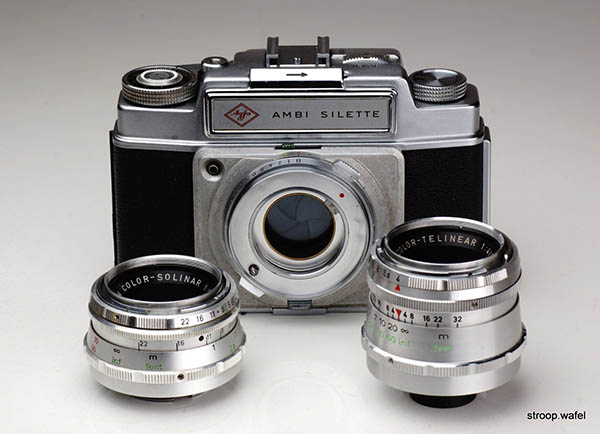
An Ambi Silette body displayed with 50mm and 90mm lenses. The name plate is very susceptible to brassing, as visible on the specimen shown here. Ambi Silettes with pristine name plates demand a high mark-up.
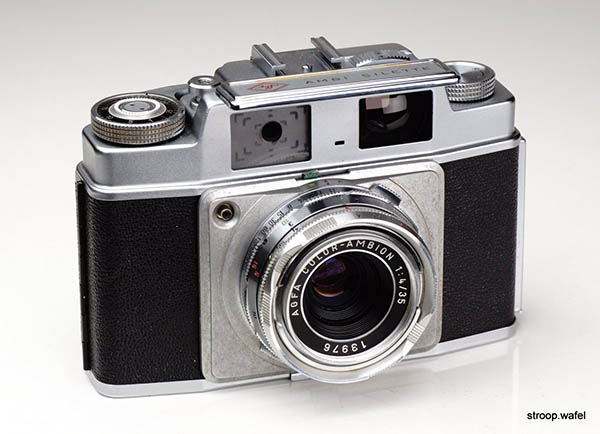
An early Ambi Silette with single rangefinder window.
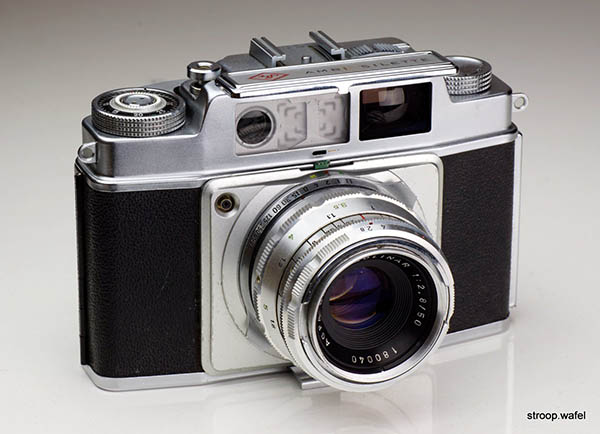
A late Ambi Silette with a separate window for projecting frames in the viewfinder window.
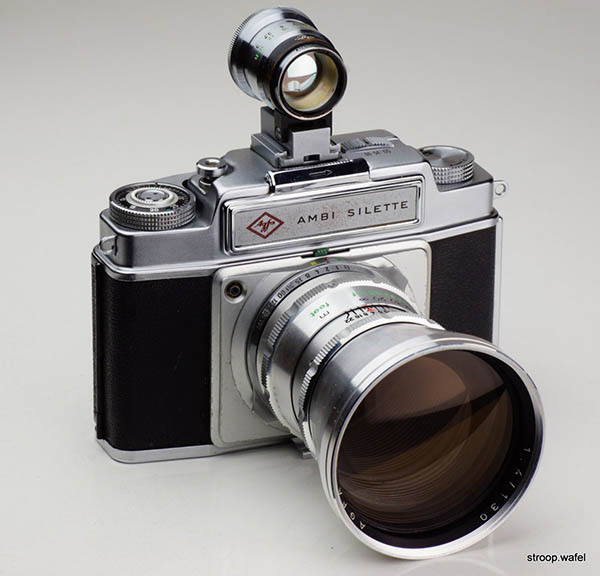
An Ambi Silette with Color-Telinear 130mm f/4 lens, the longest lens in the Ambi Silette arsenal. As no frame lines could be selected for this focal length, a separate viewfinder with parallax correction was available. A special ever-ready case which could accommodate the camera body as well as its viewfinder was also available, but unfortunately it did not fit the 130mm lens itself.
Agfa Flexilette
The Agfa Flexilette was one of the more unusual cameras made by Agfa, characterised by a large lens mount with two tiny lenses stacked on top of each other. This model was in fact a 35mm TLR camera, one of the few TLRs made for this film format, and the two lenses were the viewing and taking lens, respectively. Even the lenses look small, they were regular 45mm f/2.8 lenses. The large lens mount was a helical focus mount that moved both lenses equally during focussing. Like most TLR cameras, the Flexilette had a waistlevel viewfinder with a magnifying viewfinder. The body style was similar to the Colorflex/Ambiflex SLR range shown further below.
Even though the Flexilette is a little odd looking, I was impressed with its build quality and ease of handling.
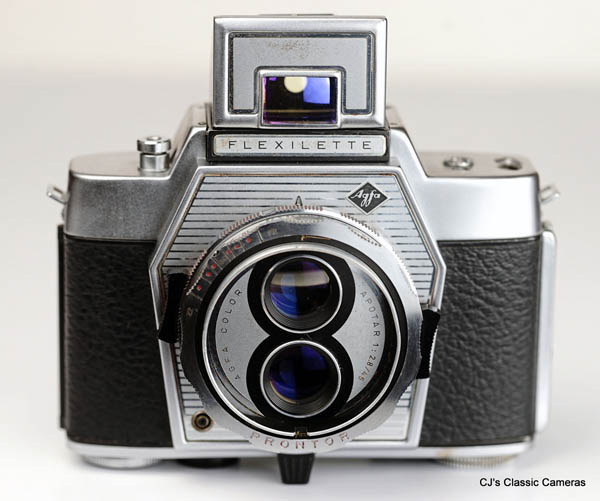
An Agfa Flexilette TLR camera with dual Color-Apotar 45mm f/2.8 lenses in Prontor shutter. Like with other Agfa cameras, some of the paint work of the inlays is rather fragile, so its hard to find them in good condition, and one needs to clean them very carefully.
Agfa Optima Reflex
The Agfa Optima Reflex was the follow up of the Flexilette TLR described above. Instead of a waste-level viefwinder it was equipped with a eye-level prism viewfinder, to which it owed it's name 'Reflex'. The Optima part of the name was related to the automatic exposure system, which was similar as that found on the Agfa Optima, which can also be found on this page. The drawback of this system is that it only works in automatic mode, so there is no manual exposure control, so if the lightmeter stops working, as is often the case nowadays, then there is no real way of using the camera. It has a flash mode setting with a fixed shutter speed of (most likely) 1/30s, but with a broken lightmeter it will default to a fully open aperture.
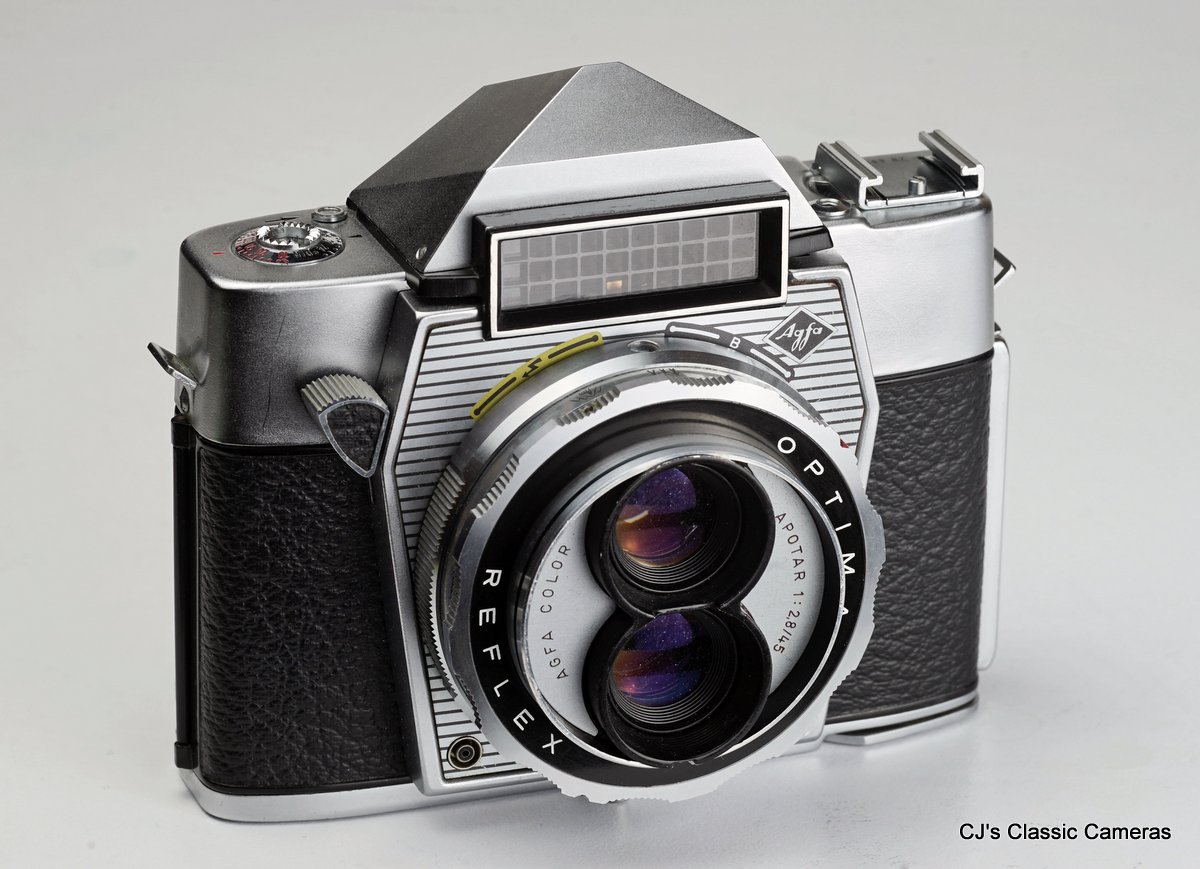
An Agfa Optima Reflex TLR camera with dual Color-Apotar 45mm f/2.8 lenses, which are the same as found on the Flexilette.
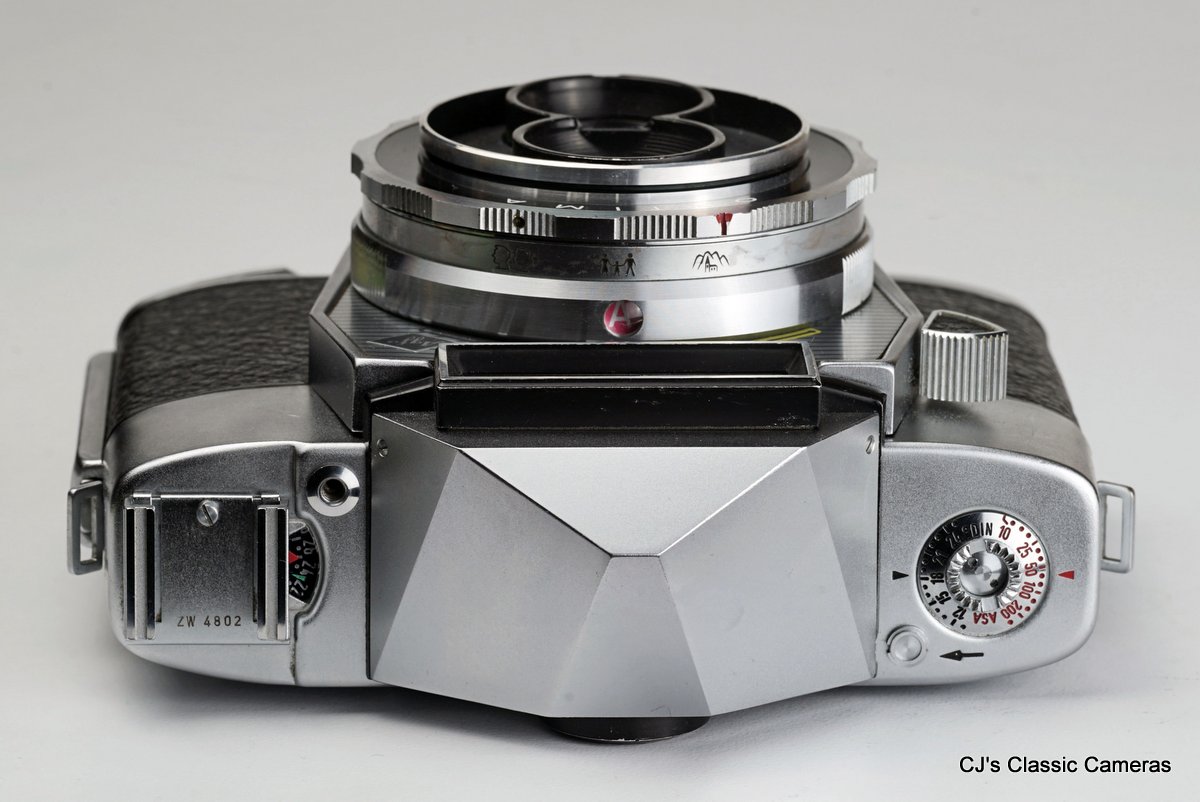
Top view of the Agfa Optima Reflex with its neat looking top housing.
Agfa Colorflex
The Agfa Colorflex was one of a range of reflex cameras produced by Agfa, which also included the Ambiflex (essentially the same camera but with interchangeable lens mount, see below), the automatic exposure Selectaflex as well as the Flexilette and Optima Reflex. The latter two were TLR cameras, the Colorflex and Ambiflex were SLR cameras, known as Agfaflex in the USA. They had interchangeable waste-level and pentaprism finders, where the Selectaflex had a fixed pentaprism finder.
The Colorflex had a leaf shutter, like other German reflex cameras like the Voigtlander Bessamatic and the Kodak Retina Reflex, instead of the more common focal plane shutter in, e.g., the Ihagee Exakta and Praktica as well as most Japanese SLR cameras. Because the shutter was in front of the mirror, it needed to be opened to make through the lens focussing possible. When one would fire the shutter, the mirror, which blocked light through the film gate, whould flip up and the film would start to be exposed until the leaf shutter closed. The mechanics differed from that of the Retina Reflex (see here) but were equally complex, which made the cameras expensive compared to focal plane SLRs.
The Colorflex had a coupled selenium lightmeter with which exposure could be set through needle matching.
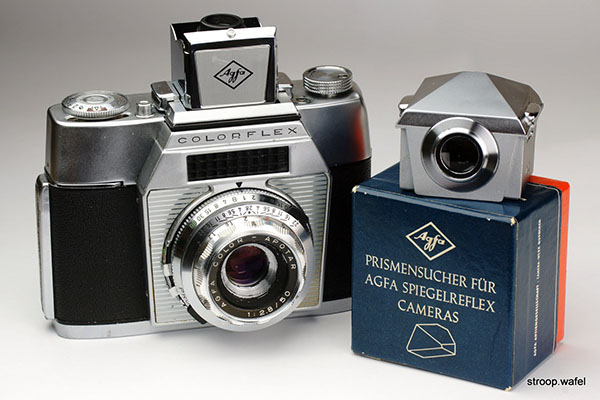
An Agfa Colorflex with fixed Color-Apotar 50mm f/2.8 lens in Prontor-Reflex shutter. It has the waistlevel viewfinder mounted. Also shown is the prismfinder including its original box.
Agfa Ambiflex
The Agfa Ambiflex was the interchangeable lens version of the Agfa Colorflex (see above). Other than the lens, the main difference between the cameras was the lightmeter, which was fully intergrated in the top housing on the Ambiflex. Interestingly, the instruction manual showed an Ambiflex with the same lightmeter as the Colorflex, so perhaps early production examples were the same.
According the brochures three different versions existed, the Ambiflex I-III, but these were all had the same camera body; it was the lens-viewfinder combination which determined the version number. Like other leafshutter SLR cameras, the Agfa Ambiflex was heavy and complicated (see Colorflex above). The lens mount was a little different from that on the Ambi Silette due to the need to have a preset aperture on the lens, as focussing was done through the lens stopping down would otherwide dim the viewfinder too much whereas the Ambi Silette had a rangefinder, on which stopping down had no effect.
The Ambiflex had a range of lens available: apart from the Solinar f/2.8 and Solagon f/2 standard lenses, there were a 35mm f/3.4 Ambion and 90mm f/3.4, 135mm f/4 and 180mm f/4.5 Telinears. As the Agfa Ambiflex is fairly rare itself, these lenses are difficult to find, but with patience I managed to get them all (see photo further down). Note that in the US the Ambiflex was sold as the Agfaflex.
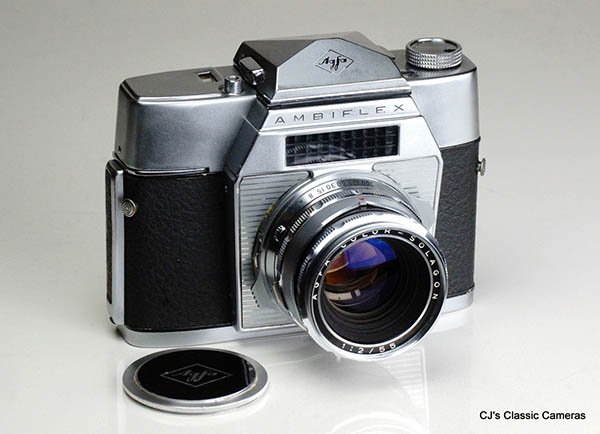
An Agfa Ambiflex with interchangeable Color-Solagon 55mm f/2 lens and pentaprism viewfinder, which makes this an Ambiflex III. The six-element Solagon lens was first introduced on the Agfa Karat 36 v3 and had an excellent reputation. The interchangeble version shown here can go for pretty high prices these days, although I am not aware of any adapters to us is on digital cameras (note: these are now occasionally available).
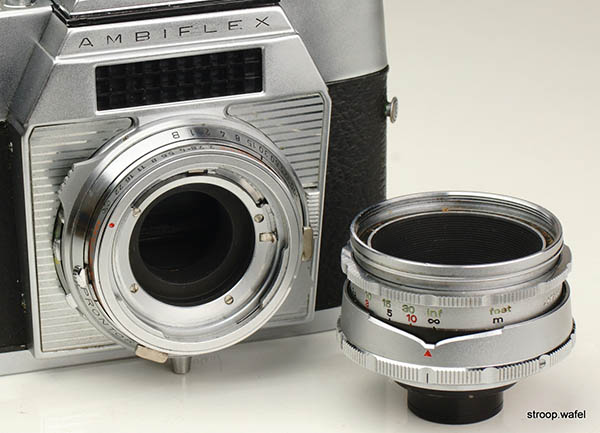
Detail of the lens mount of the Agfa Ambiflex, which was different from that of the Ambi Silette. This may seems annoying, but they were very different systems. The Ambi Silette mount needed a rangefinder cam, which the Ambiflex did not, but instead it needed an aperture control mechanism that closed the lens aperture only when the shutter was released, as to allow through-the-lens focusing at maximum aperture.
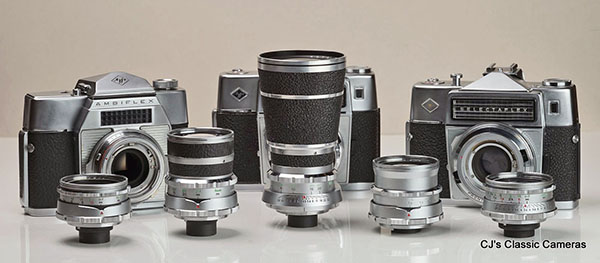
As far as I am aware, this is the full range of cameras and lenses in the Ambiflex/Selectaflex range (see below for more details on the Selectaflex), apart from the standard 50mm Solinar lens. From left to right: 50mm f/2 Color-Solagon, 135mm f/4, 180mm f/4.5 and 90mm f/3.4 Telinear, and 35mm f/3.4 Ambion. In the background the Ambiflex and two variants of the Selectaflex; the one in the centre is better visible below.
Agfa Selectaflex
The Agfa Selectaflex was similar to the Ambiflex but featured semi-automatic exposure, i.e., it would select the appropriate aperture for a preselected shutter speed. It had an interchangeable lens mount very similar to the Ambiflex (see below for discussion). It also had a similar design but was easily recognisable by the very large lightmeter window above the lens. It had a fixed eye level (pentaprism) finder so no longer it had the option of a waist level finder like on the Ambiflex. The camera could also function in fully manual mode, during which the recommended aperture setting would be indicated in the viewfinder. A few slightly different versions exist, mainly differing in the size of the Selectaflex logo on the front. The Selectaflex I and II came with a Solinar f/2.8 and Solagon f/2, respectively.
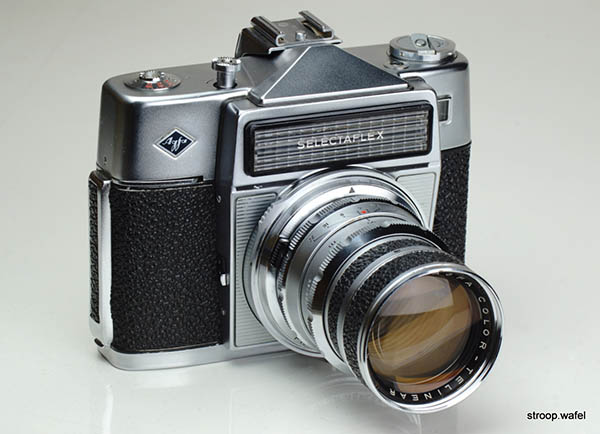
An Agfa Selectaflex with interchangeable Agfa Color-Telinear 135mm f/4 lens. The accessory shoe was removable - it could be simply pulled off, which is a little unnerving if you happened to have an expensive flash unit.
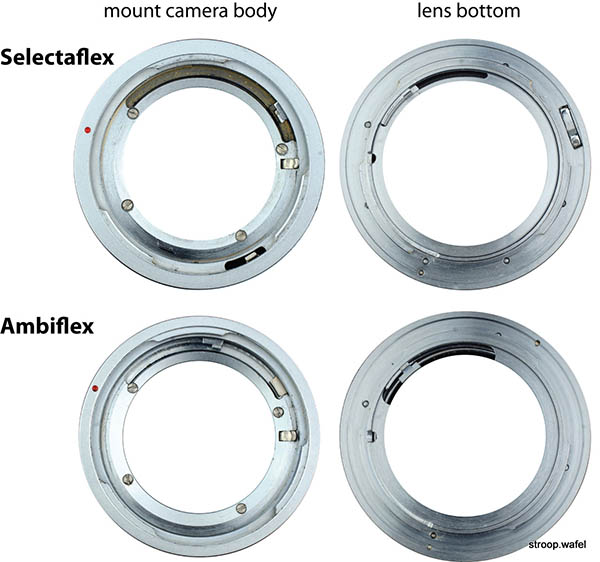
Details of the lens mounts of Selectaflex and Ambiflex, which differ in detail. I was able to mount a Selectaflex lens on the Ambiflex, but not vice versa. I am also unsure about the small insert in the bottom of the lens mount of the Selectaflex. If anyone has any more info it would be highly appreciated!
Agfa Clack
Although magnificent in their own right, the above cameras certainly did not tick the boxes cheap and cheerful, or portable, which would make it appeal to a wider audience. Agfa was clearly well aware of this, as in the mid-50s they came out with the Clack. This was not much more than a box camera with a single speed shutter (+ a bulb setting) and a fixed focus lens. It produced 6x9 cm frames on 120 rollfilm, which is rather impressive considering the camera's relatively small size, but due to the camera's cheap specifications these frames were really only meant for 1:1 contact prints, not enlargements. The long telescopic viewfinder showed a better defined frame than most other similar cameras, but all in all this camera was clearly designed to cater to the masses and to withstand a fair amount of abuse. This strategy clearly worked, as the Clack was in production for 10 years and plenty of them are still around these days, usually still working.
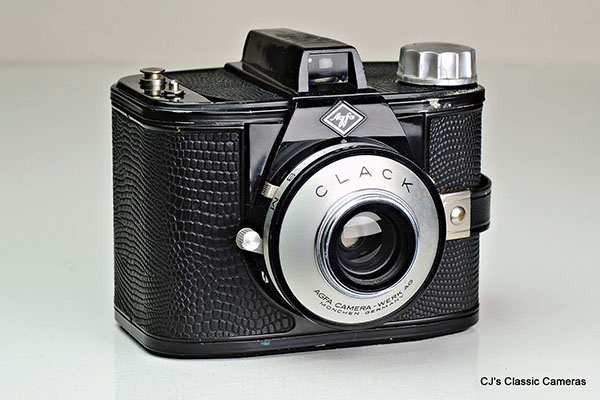
An Agfa Clack with its rather eye-catching patterned leatherette covering. Also note the build-in carrying strap on the right.
Agfa Selecta-m
The Agfa Selecta-m wasn't really an Agfa camera, it was a modified Iloca Auto-Electric with Agfa logo. Iloca went bankrupt in 1960 because its supplier stopped delivering shutters and the company was probably already not doing too well financially due to the limited commercial success of the magnificent but expensive Iloca Electric. The Iloca Auto-Electric was the first fully automatic camera with an electric motorwind (first introduced on the Iloca Electric) and automatic exposure (shutter priority mode only). It never came in production due to Iloca's demise.
Agfa picked up the pieces and introduced in 1962 the Selecta-m with only small modifications compared to the original Iloca Auto-Electric. By that time Agfa had already introduced several cameras with automatic exposure, including the Optima range and the Selecta with fully and half-automatic exposure, respectively. Until it introduced the Selecta-m Agfa had no cameras with motorwind, so that was presumably what the 'm' stood for: motorwind (or rather, motorantrieb in German).
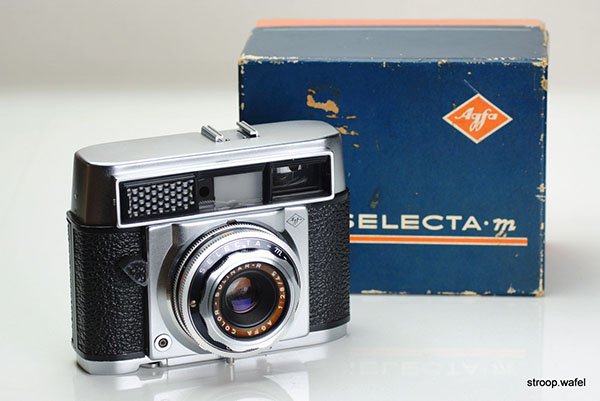
An Agfa Selecta-m with its original box. This camera came with a receipt from 1968 when it sold for £34-19-6d (six pennies short of £35), presumably secondhand or perhaps old stock as it was several years after the camera went out of production.
It was a well-specified camera with a coincidence rangefinder with parallax control, a four element lens made by Rodenstock, and a warning sign in the viewfinder if the light was not good enough to take a photo with the selected shutter speed. The motordrive allowed taking about 2 frames/second whilst keeping the release lever pressed down. However, the camera suffered from the same problem as the Iloca Electric: it was very heavy and, more importantly, very expensive. Its success was therefore limited. But remember the camera (and its predecessor Iloca Electric) was far ahead of its time; it would take several decades before battery-driven film advance became standard.
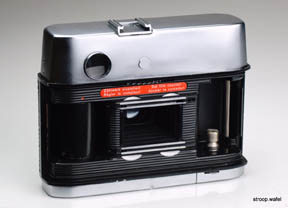
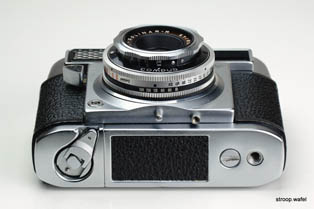
(left) Interior of an Agfa Selecta-m, which is very similar to that of the Iloca Electric. The motor wind is integrated in the wind spool on the left. (right) Bottom view of the Selecta-m, again very similar to the Iloca Electric, including the battery compartment cover and the rather idiosyncratic back release.
Agfa Silette I
What can I say. It has a lens. It takes pictures. It doesn't weigh much. You'd probably take it to the beach on a sunny day and take pictures of your family with it. Which is perfectly fine. It was probably even a good package for the price and made photography more affordable for the person in the street. But if I lived in 1962 I think a Retinette IA or IB had a lot more going for it.
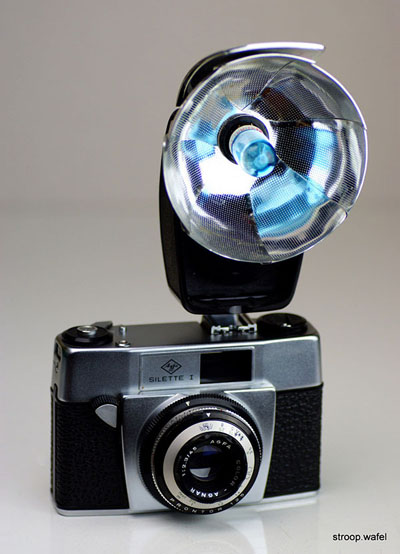
|
|
Agfa Silette I with Agfalux flash unit to make it a little more interesting.
|
Agfa Iso-Rapid I
But it got worse. Look at this little plastic brick, the Iso-Rapid. A real point and shoot camera, the only adjustment it had was for daylight or flash photography. Film speed setting was done through the Rapid cassette system it used, read more about that in the Minolta Rapid 24 section. But the camera did feature a hot shoe and automatically set the frame counter to 0 after opening the back. Several different variants of the Iso-Rapid were made, some slightly more advanced than this most basic model.
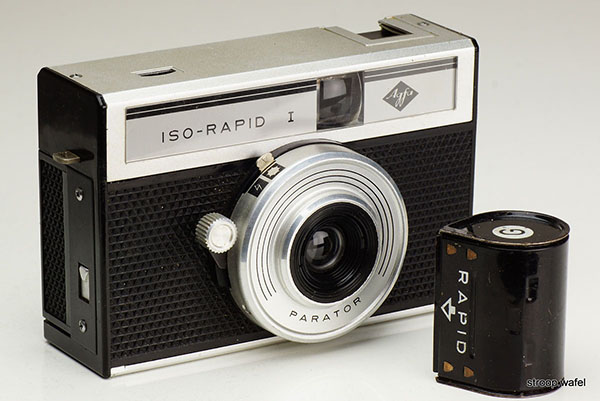
An Agfa Iso-Rapid I shown with the Rapid cassette it used for film.
Agfamatic 200 Sensor
This isn't particularly well known, but Agfa kept producing cameras for a very long time, in fact the brand name still exists, as a large imaging corporation (Agfa) including a photographic division (Agfaphoto). The original company went bankrupt in 2004 though, so it's only the name and sold-off assets that survive, plus indeed the branding, but nevertheless, the current Agfa company does list its full over 150 year history.
An example of one of the later models by the original Agfa company is the Agfamatic Sensor shown below, made in the late 1970s, perhaps early 80s. Small, light and compact but limited in its features. If you're after a 35mm camera to actually use, you may consider the Agfa Optima 1035 or 1535 rangefinders, which were pretty decent shooters in a similar style as the Agfamatic.
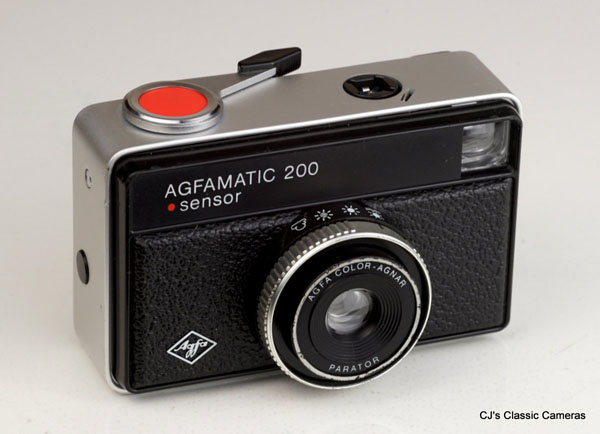
An Agfamatic Sensor 200, an instamatic camera for use with 126 film cassettes. Not much of a camera to be honest, but what I like about it is that is still has the same Agfa logo and oranges accents as the first camera on this page, which dated from 1926. In fact, the logo of the current company Agfaphoto is based on the shutter button of the Agfamatic and similar cameras: an orange circle with a grey ring.
| 
